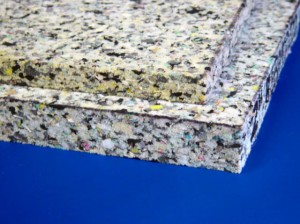Sitting Pretty: Outfit Specialty Seating Applications With Durable Rebond Foam
When people are able to decide what kind of seat cushioning foam they put in their chairs or couches, they often say that they want the firmest, longest-lasting foam possible. Generally, this is said with traditional high-density foam for cushions in mind. However, many consumers aren’t aware that specialty open-cell foam types exist that can easily surpass standard cushioning foam in density, firmness, and durability. Open-cell rebond foam is one of these specialty materials.
Rather than a poured and expanded polyurethane product, rebond is created by bonding already-formed shredded foam under compression with adhesive. The bonding agents and compression combine to add strength and rigidity that allows the 1LB to 2LB density materials that typically make up rebond to be formed into a material with a 7LB-and-greater density. On the flip side, this is also why rebond material is generally too hard for comfortable use as residential chair padding and mattresses.
That isn’t to say rebond can’t fill a niche in the comfort industry, only that most applications don’t need the strength and firmness it provides. But for applications like industrial seating, as well as cushioning recreational vehicles, rebond provides durability with enough comfort to meet those uses’ demands.
Industrial, public, and commercial seating has a very different set of requirements than the seating in a living room set. Church pews or restaurant booths, for example, receive daily use and abuse that residential seating couldn’t and wouldn’t be expected to bear. Consider the pressure kneeling pew cushions receive, or the forces generated by people sliding on and off stools at bistros and pubs all day. This high-impact and omni-directional wear would turn lesser foam into dust, but when padded with rebond’s strength, these seats are able to handle the abuse while still being more comfortable than a wooden pew or bench. Downtime caused by reupholstering seats isn’t something most places can afford or want to subject their patrons to. Fortunately, rebond foam is able to provide the necessary long-term padding.
Another demanding application where rebond does what other materials can’t is in seating for recreational vehicles. ATV seats, motorcycle seats, and even a snowmobile seat not only have to endure punishment from the rider’s movements, but also the constant vibrations created by the engine. These motor vibrations can accelerate the breakdown of a material not intended for such use, but again, rebond is able to last where other materials cannot. Rebond is firm enough to give riders the support needed to stay confidently in control of their vehicles, while also being able to be customized to the rider’s comfort preferences. Custom motorcycle seats are particularly popular, as they are able to be cut from larger blocks or glued together from sheets. Whether seats are worn out after years of use or don’t offer the right fit, a DIY motorcycle seat made of rebond foam can improve the open-road experience.
The versatility of foam materials is hard to match when you consider how many varieties of foam there are, and all the places you can find them in use. Even for specialized applications, there’s often a unique foam that’s perfect for the job. Rebond’s ability to perform in applications that require durable seating is a perfect example of this.
The Foam Factory stocks 7LB, 70ILD rebond foam in 1 and 2 inch thickness and sheets in two different sizes. For more information, visit its product page on TheFoamFactory.com.
Tags: DIY Seat, Motorcycle Seat, Open-Cell Foam, Rebond Foam, Specialty Foam
Posted in Cushions, Industrial



I’m looking for rebound foam hard
Cut 8” /25 80 long or more
I will like to get 20 or 30 those
Although we no longer carry Rebond foam, we may have foam that will work for your application. Please Contact Usfor more information on the best foam for your application.
I am looking for foam for a cushion, but we don’t have much room for thickness so I was looking to get rebound foam that’s 2 in thick instead of a firm foam. Would rebound foam be a good choice for this.
Please Contact Usdirectly for more information regarding your inquiry.